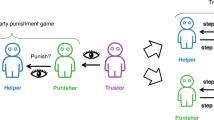Abstract
Humans have learned to cooperate in many ways and environments; on different tasks; and for achieving different goals. Collaboration and cooperation in their more general sense (and in particular: negotiation, exchange, help, delegation, adoption, and so on) are an important characteristic — or better, one of the foundational aspects — of human societies.
Preview
Unable to display preview. Download preview PDF.
Similar content being viewed by others
References
Q. He, K. Sycara, and Z. Su, (2001), Security infrastructure for software agent society, in C. Castelfranchi and Y. Tan (Eds), Trust and Deception in Virtual Societies, Kluwer Academic Publishers, pp.139–156.
Castelfranchi C., Falcone R., (1998) Principles of trust for MAS: cognitive anatomy, social importance, and quantification, Proceedings of the International Conference on Multi-Agent Systems (ICMAS’98), Paris, July, pp.72–79.
R. Falcone and C. Castelfranchi, (2001), Social Trust: A Cognitive Approach, in C. Castelfranchi and Y. Tan (Eds), Trust and Deception in Virtual Societies, Kluwer Academic Publishers, pp.55–90.
Castelfranchi C., Falcone R., (2000), Trust and Control: A Dialectic Link, Applied Artificial Intelligence journal, Special Issue on Trust in Agents Part1, Castelfranchi C., Falcone R., Firozabadi B., Tan Y. (Editors), Taylor and Francis 14 (8), pp. 799–823.
M. Bacharach and D. Gambetta, (2001), Trust as Type Detection, in C. Castelfranchi and Y. Tan (Eds), Trust and Deception in Virtual Societies, Kluwer Academic Publishers, pp.1–26.
Author information
Authors and Affiliations
Editor information
Editors and Affiliations
Rights and permissions
Copyright information
© 2001 Springer-Verlag Berlin Heidelberg
About this paper
Cite this paper
Falcone, R., Singh, M., Tan, YH. (2001). Introduction: Bringing Together Humans and Artificial Agents in Cyber-societies:A New Field of Trust Research. In: Falcone, R., Singh, M., Tan, YH. (eds) Trust in Cyber-societies. Lecture Notes in Computer Science(), vol 2246. Springer, Berlin, Heidelberg. https://doi.org/10.1007/3-540-45547-7_1
Download citation
DOI: https://doi.org/10.1007/3-540-45547-7_1
Published:
Publisher Name: Springer, Berlin, Heidelberg
Print ISBN: 978-3-540-43069-8
Online ISBN: 978-3-540-45547-9
eBook Packages: Springer Book Archive




